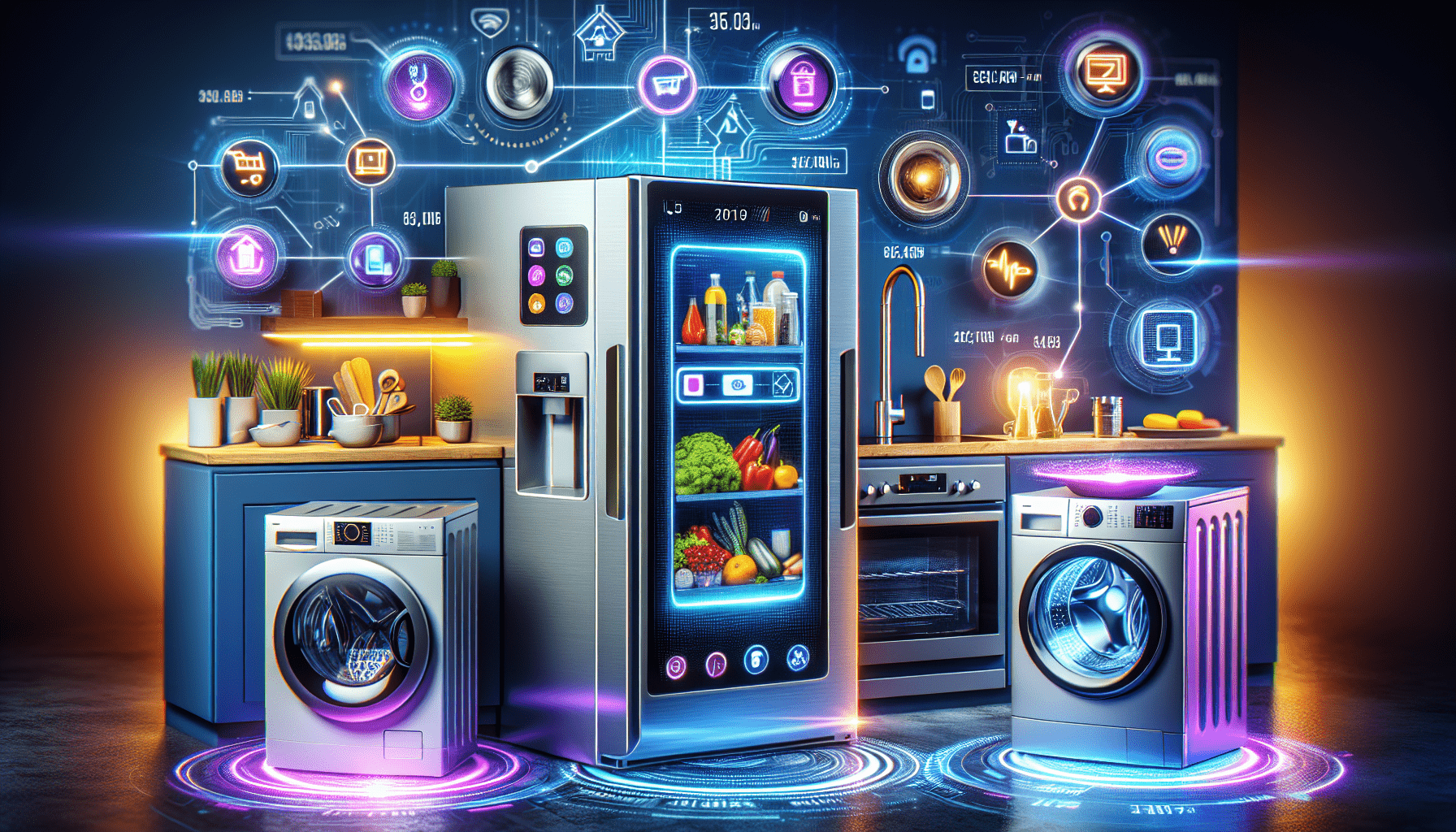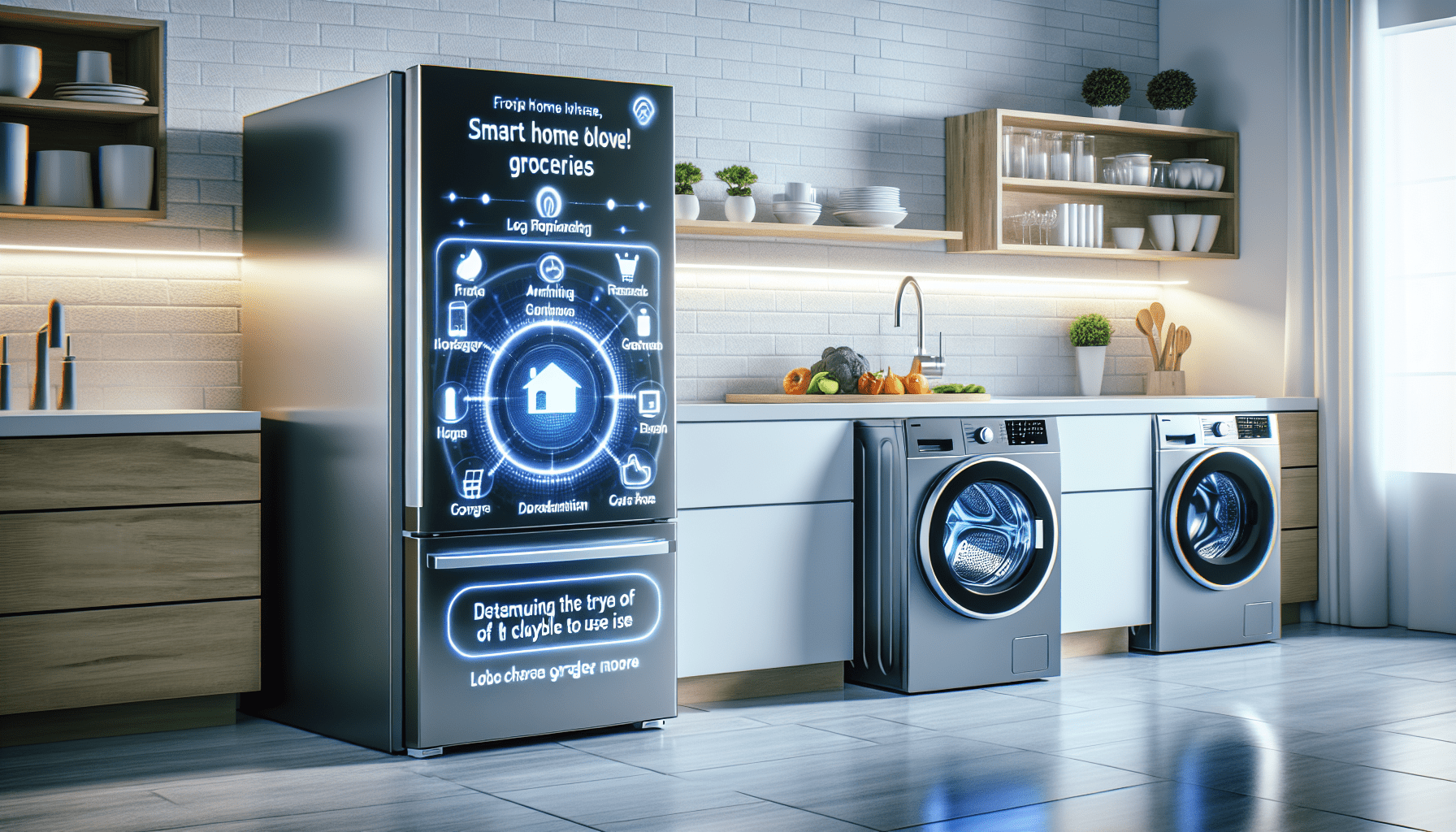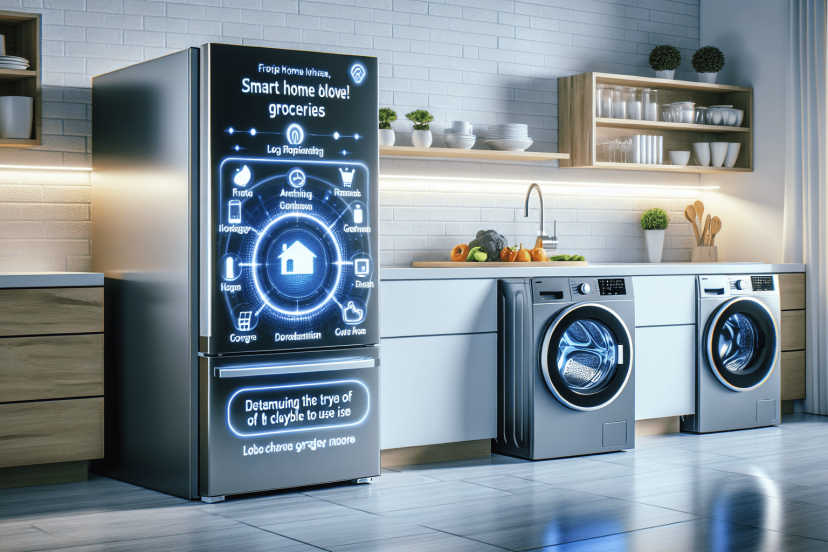How Do Smart Appliances Work?
Imagine living in a world where your appliances can anticipate your needs and make your life easier. smart appliances have revolutionized the way we interact with our everyday household items, bringing convenience and efficiency to a whole new level. But have you ever wondered how these technological marvels actually work? In this article, we will unravel the mysteries behind smart appliances and discover the fascinating mechanisms that allow them to seamlessly integrate into our lives. From interconnected sensors to intelligent programming, get ready to embark on a journey through the inner workings of these magical devices.

1. Introduction
Smart appliances have become increasingly popular in modern homes, offering convenience, efficiency, and enhanced functionality. These appliances are interconnected with the internet and utilize advanced technologies to provide users with a seamless and intuitive experience. In this article, we will explore the definition and capabilities of smart appliances and delve into the underlying technologies that power them. From Internet of Things (IoT) technology to artificial intelligence and machine learning, we will uncover how these appliances are transforming the way we interact with our household devices. Additionally, we will discuss the various connectivity options, mobile applications, and voice control features that further enhance the user experience. Energy efficiency and smart grid integration, as well as security and privacy concerns, will also be explored. Lastly, we will look into future innovations and the potential challenges and opportunities that lie ahead in the realm of smart appliances.
2. Definition of Smart Appliances
Smart appliances refer to household devices that are equipped with internet connectivity and advanced technological features. These appliances are designed to provide enhanced functionality, automation, convenience, and energy efficiency. They can communicate and interact with other devices and systems within a smart home environment, allowing users to control and monitor them remotely through various interfaces such as smartphones, tablets, or voice assistants. While traditional appliances may serve a singular purpose, smart appliances integrate cutting-edge technologies to offer a range of features and capabilities that simplify and streamline everyday tasks.
3. Internet of Things (IoT) Technology
3.1. Explanation of IoT
The Internet of Things (IoT) is a network of physical objects embedded with sensors, software, and connectivity capabilities, enabling them to collect and exchange data over the internet. These objects, which can include appliances, wearables, vehicles, and more, become smart and interconnected, allowing for seamless communication and automation. IoT technology forms the backbone of smart appliances, enabling them to connect to the internet, share data, and interact with users and other devices.
3.2. Role of IoT in Smart Appliances
IoT technology plays a crucial role in powering smart appliances. By connecting to the internet, these appliances are capable of transmitting and receiving data, enabling seamless communication with users and other devices. Through IoT, smart appliances can be remotely controlled, monitored, and managed, enhancing convenience and providing real-time insights. Moreover, IoT enables data-driven functionalities, such as predictive maintenance and energy optimization, ultimately improving the overall performance and efficiency of these appliances.
3.3. Connection and Communication Protocols
Smart appliances utilize various connection and communication protocols to establish a seamless connectivity network. Common protocols include Wi-Fi, Bluetooth, Zigbee, Z-Wave, and Thread. Wi-Fi is widely used for its high-speed wireless connection, allowing for easy integration with home networks and internet access. Bluetooth is utilized for short-range wireless communication between devices, while Zigbee, Z-Wave, and Thread are mesh network protocols designed for smart home applications, offering low-power consumption and broader coverage. The choice of protocol depends on factors such as range, data transfer speed, power consumption, and compatibility with other devices in the smart home ecosystem.

4. Sensors and Data Collection
4.1. Types of Sensors Used
Smart appliances incorporate various sensors to collect data and monitor their surroundings. These sensors can include temperature sensors, humidity sensors, motion sensors, light sensors, touch sensors, and more. For example, a smart thermostat may employ temperature and humidity sensors to regulate indoor climate, while a smart refrigerator may utilize light sensors to detect when the door is opened. These sensors enable appliances to gather information, adjust settings accordingly, and provide personalized experiences to users.
4.2. Data Collection and Analysis
Data collection is a fundamental aspect of smart appliances, as it enables the extraction of valuable insights and information. Through sensors and connected systems, appliances continuously collect data about usage patterns, energy consumption, environmental conditions, and user preferences. This data is then analyzed and processed to generate actionable insights and improve appliance functionalities and performance. The analysis of data allows for automated adjustments, energy optimization, and the delivery of personalized experiences to users.
4.3. Importance in Appliance Functionality
Sensors and data collection play a vital role in the functionality of smart appliances. By constantly monitoring and collecting data, these appliances can adapt to user preferences, optimize energy consumption, and automate processes. For instance, a smart washing machine can adjust water usage and cycle duration based on the load size and soil level detected by its sensors. By leveraging data-driven insights, smart appliances can deliver enhanced performance, improved efficiency, and a tailored experience that meets the unique needs of users.
5. Artificial Intelligence and Machine Learning
5.1. Integration of AI and ML
Smart appliances leverage artificial intelligence (AI) and machine learning (ML) technologies to further enhance their capabilities. AI refers to the simulation of human intelligence in machines, allowing them to perform tasks that typically require human intelligence. ML, on the other hand, is a subset of AI that enables machines to learn from data and improve their performance over time without explicit programming. Through the integration of AI and ML, smart appliances can analyze large datasets, learn user preferences, and make intelligent decisions to provide personalized experiences and automate tasks.
5.2. Learning Patterns and User Preferences
AI and ML algorithms enable smart appliances to learn and recognize patterns in user behavior, preferences, and usage patterns. For example, a smart oven can learn the preferred cooking settings for a particular recipe over time, automatically adjusting temperature and cooking time to achieve optimal results. By understanding individual preferences, smart appliances can adapt their functionalities to deliver a personalized experience, saving users time and effort.
5.3. Adaptive and Predictive Functions
The integration of AI and ML also empowers smart appliances to offer adaptive and predictive functions. These appliances can analyze data from sensors, user inputs, and external sources to accurately predict user needs and automate processes. For instance, a smart vacuum cleaner can adapt its cleaning route based on the layout of a room and the detection of obstacles. Through adaptive and predictive functions, smart appliances can simplify everyday tasks, optimize performance, and anticipate user requirements.
6. Connectivity Options
6.1. Wi-Fi Connectivity
Wi-Fi connectivity is a common feature in smart appliances, enabling seamless integration with home networks and the internet. Wi-Fi connectivity allows for remote access and control of appliances through mobile applications or voice assistants. By connecting to the internet, smart appliances can send and receive data, receive software updates, and interact with other devices and systems within a smart home.
6.2. Bluetooth and Other Wireless Technologies
In addition to Wi-Fi, smart appliances may utilize Bluetooth and other wireless technologies for specific purposes. Bluetooth enables short-range communication between devices, making it ideal for connecting smartphones, tablets, or wearables with appliances. This connectivity option allows users to interact with appliances in close proximity, facilitating tasks such as streaming media or transferring data. Other wireless technologies, such as Zigbee and Z-Wave, are commonly employed in smart home ecosystems to establish a mesh network that extends the range and coverage of smart devices.
6.3. Integration with Smart Home Systems
Smart appliances are designed to seamlessly integrate with smart home systems, allowing for centralized control and automation. These systems, often controlled through a hub or a smart speaker, serve as the command center for all connected devices within the home. By integrating with smart home systems, appliances can communicate and collaborate with other devices, enabling sophisticated automation and synchronization. For example, a smart home system can adjust lighting, temperature, and security settings based on user preferences or specific events.
7. Mobile Applications and Voice Control
7.1. User Interface via Mobile Apps
Smart appliances are typically accompanied by mobile applications that serve as the primary user interface for controlling and monitoring these devices. Mobile apps provide a convenient and intuitive platform for users to adjust settings, access information, and receive real-time notifications. Through mobile apps, users can remotely control their appliances, schedule tasks, monitor energy consumption, and receive alerts or notifications. These apps often feature user-friendly interfaces and customizable settings, enhancing the user experience and allowing for seamless integration with other smart home devices.
7.2. Voice Assistant Integration
Voice control has emerged as a popular and convenient method of interacting with smart appliances. By integrating with voice assistants such as Amazon Alexa or Google Assistant, smart appliances can be controlled and managed through voice commands. Users can simply speak commands or questions, and the voice assistant interprets and executes the requested actions. Voice control adds a new level of convenience and accessibility, allowing users to operate appliances hands-free and from a distance.
7.3. Remote Access and Control
Mobile applications and voice control enable users to remotely access and control their smart appliances from anywhere with an internet connection. Whether you are at work, traveling, or simply in another room, you can conveniently monitor and adjust your appliances through your smartphone or voice commands. This remote access and control feature offers flexibility, convenience, and peace of mind, ensuring that you can efficiently manage your appliances and receive real-time updates regardless of your location.
8. Energy Efficiency and Smart Grid Integration
8.1. Energy Monitoring and Optimization
Energy efficiency is a key advantage of smart appliances. These appliances are equipped with energy monitoring features that allow users to track and analyze their energy consumption. Smart meters and sensors provide real-time data on energy usage, enabling users to identify energy-intensive processes or devices. By understanding their energy consumption patterns, users can make informed decisions to optimize usage and reduce their environmental footprint.
8.2. Demand Response and Peak Load Management
Smart appliances can actively participate in demand response programs and peak load management to support the stability and efficiency of the electrical grid. During periods of high electricity demand, utility companies can send signals to smart appliances to temporarily reduce energy consumption. For example, a smart HVAC system can adjust temperature settings or cycle duration to reduce the load on the grid during peak hours. By intelligently managing energy demand, smart appliances contribute to a more efficient and sustainable energy ecosystem.
8.3. Interaction with Smart Grid Infrastructure
Smart appliances can interact and communicate with the smart grid infrastructure, allowing for real-time information exchange and coordination. Through this interaction, appliances can receive signals or pricing information from utility companies, enabling them to optimize their operation accordingly. For instance, a smart dishwasher can delay its operation until off-peak hours to take advantage of lower electricity rates. By integrating with the smart grid infrastructure, smart appliances enable efficient energy usage, cost savings, and a more sustainable energy future.
9. Security and Privacy
9.1. Data Security Measures
With the increasing connectivity and data exchange involved in smart appliances, ensuring data security is of paramount importance. Smart appliances employ various security measures to protect user information and mitigate the risk of unauthorized access or data breaches. These measures can include encryption, secure authentication protocols, and regular software updates to address vulnerabilities. Additionally, manufacturers implement stringent security standards and undergo testing and certification processes to ensure the integrity and privacy of user data.
9.2. Privacy Concerns and Solutions
While smart appliances offer numerous benefits, they also raise concerns about privacy. As these devices collect and transmit data, there is a potential risk of unauthorized access or data misuse. To address these concerns, manufacturers prioritize privacy protection by implementing privacy policies, providing transparent data usage disclosures, and allowing users to control the collection and sharing of their data. Additionally, users can take steps to secure their smart appliances, such as setting strong passwords, ensuring Wi-Fi network security, and regularly updating firmware or software.
9.3. Vulnerabilities and Countermeasures
Like any technology, smart appliances may have vulnerabilities that could be exploited by malicious actors. Manufacturers and developers actively work to identify and address potential vulnerabilities through frequent software updates and collaboration with security experts. Users can also mitigate risks by staying informed about security best practices, adopting security measures such as firewalls or antivirus software, and promptly installing software updates for their appliances. By remaining vigilant and proactive, users can enjoy the benefits of smart appliances while minimizing security risks.
10. Future Innovations and Integration
10.1. Expansion of Smart Home Ecosystem
The future of smart appliances will witness an expansion of the smart home ecosystem, with an increasing number of interconnected devices and systems. This growth will enable even more seamless automation and integration, allowing appliances to work together harmoniously. Advanced technologies such as augmented reality, virtual assistants, and advanced robotics are likely to be integrated into smart appliances, enhancing their capabilities and further simplifying tasks.
10.2. Integration with Smart Cities and Infrastructure
Smart appliances will also become an integral part of the larger smart city infrastructure. The integration of smart appliances with public utilities, transportation systems, and energy grids will enable more efficient and sustainable urban living. For example, smart appliances can contribute to optimized energy distribution, intelligent waste management, and enhanced urban mobility. As smart cities continue to evolve, smart appliances will play a vital role in creating a more connected and sustainable urban environment.
10.3. Potential Challenges and Opportunities
As the adoption of smart appliances continues to rise, there will be challenges and opportunities to address. Interoperability, compatibility, and standardization will be key considerations to ensure seamless integration and communication among different devices and platforms. Additionally, addressing concerns related to data security, privacy, and energy consumption will be crucial for the widespread acceptance and trust in smart appliances. However, these challenges present opportunities for innovation, collaboration, and the development of new technologies and solutions that further enhance the functionality, efficiency, and convenience of smart appliances.
In conclusion, smart appliances offer a plethora of benefits, ranging from convenience and efficiency to energy savings and automation. By leveraging IoT technology, sensors, AI, and connectivity options, these appliances revolutionize the way we interact with household devices. Whether it’s controlling appliances remotely through mobile apps, utilizing voice assistants for hands-free operation, or optimizing energy consumption through smart grid integration, smart appliances empower users to streamline their daily routines and lead more connected and sustainable lives. With continuous advancements and future innovations, smart appliances will continue to transform the way we live and interact with our homes, creating a more intelligent and effortless living experience.




